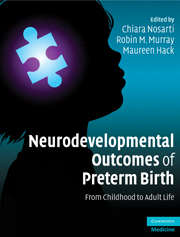Book contents
- Frontmatter
- Contents
- List of contributors
- Preface
- Section 1 Introduction
- Section 2 Neuroimaging
- 4 Imaging the preterm brain
- 5 Structural magnetic resonance imaging
- 6 Magnetic resonance imaging findings from adolescence to adulthood
- 7 Functional neuroimaging following very preterm birth
- 8 Diffusion tensor imaging findings in preterm and low birth weight populations
- Section 3 Behavioral outcome
- Section 4 Neuropsychological outcome
- Section 5 Applied research
- Section 6 Conclusions
- Index
5 - Structural magnetic resonance imaging
from Section 2 - Neuroimaging
Published online by Cambridge University Press: 06 July 2010
- Frontmatter
- Contents
- List of contributors
- Preface
- Section 1 Introduction
- Section 2 Neuroimaging
- 4 Imaging the preterm brain
- 5 Structural magnetic resonance imaging
- 6 Magnetic resonance imaging findings from adolescence to adulthood
- 7 Functional neuroimaging following very preterm birth
- 8 Diffusion tensor imaging findings in preterm and low birth weight populations
- Section 3 Behavioral outcome
- Section 4 Neuropsychological outcome
- Section 5 Applied research
- Section 6 Conclusions
- Index
Summary
Introduction
It has been long recognized that the survivors of very preterm birth and very low birth weight (VLBW) have a relatively high prevalence of major neurodevelopmental sequelae in childhood years. Early major motor problems such as cerebral palsy and later cognitive, behavioral, and minor motor impairments have all been extensively described [1]. While cranial ultrasound examination immediately after birth has been demonstrated to be successful in predicting major motor difficulties at school age with some accuracy, it has proved much less useful in studying the origins of lesser impairments, and is of little value outside the neonatal period (see also Chapters 3 and 4). The increasing use of magnetic resonance imaging (MRI) of the head, as a research tool in childhood during the last two decades, together with long-term follow-up and assessments, has considerably increased our understanding of brain development after preterm birth.
Whilst early use of MRI often necessitated long acquisition times, more powerful magnetic fields in modern scanners have enabled, at least in older children, more rapid imaging to be achieved with minimal or no sedation. In addition, more recent techniques such as diffusion-weighted imaging, functional MRI, vascular MRI, and tractometry have greatly increased the types of information that can be obtained.
Published studies have concentrated on area or volume measurements of whole brain and specific areas of the brain such as the caudate nucleus, cerebellum, hippocampus, or cortical regions, and correlated these with behavioral, cognitive or motor outcomes.
- Type
- Chapter
- Information
- Neurodevelopmental Outcomes of Preterm BirthFrom Childhood to Adult Life, pp. 54 - 67Publisher: Cambridge University PressPrint publication year: 2010
- 1
- Cited by



